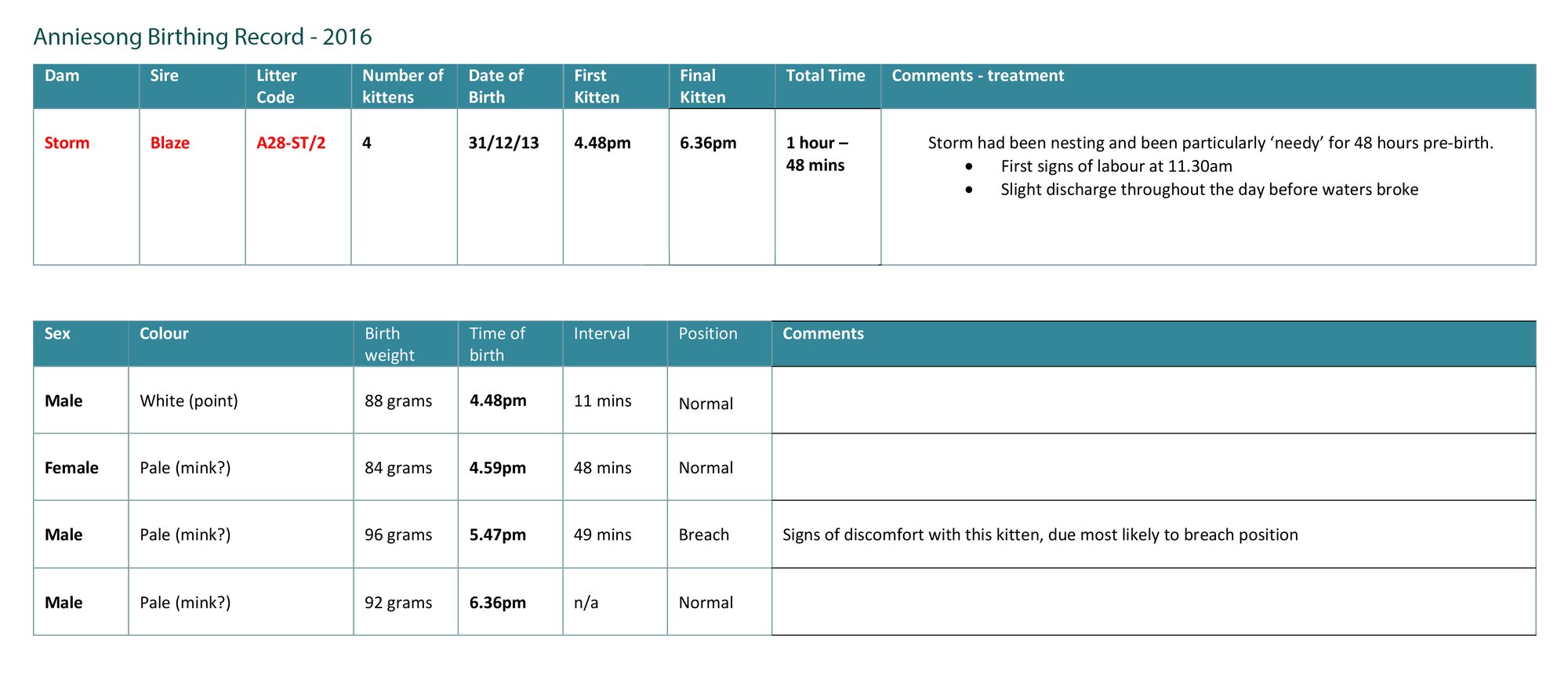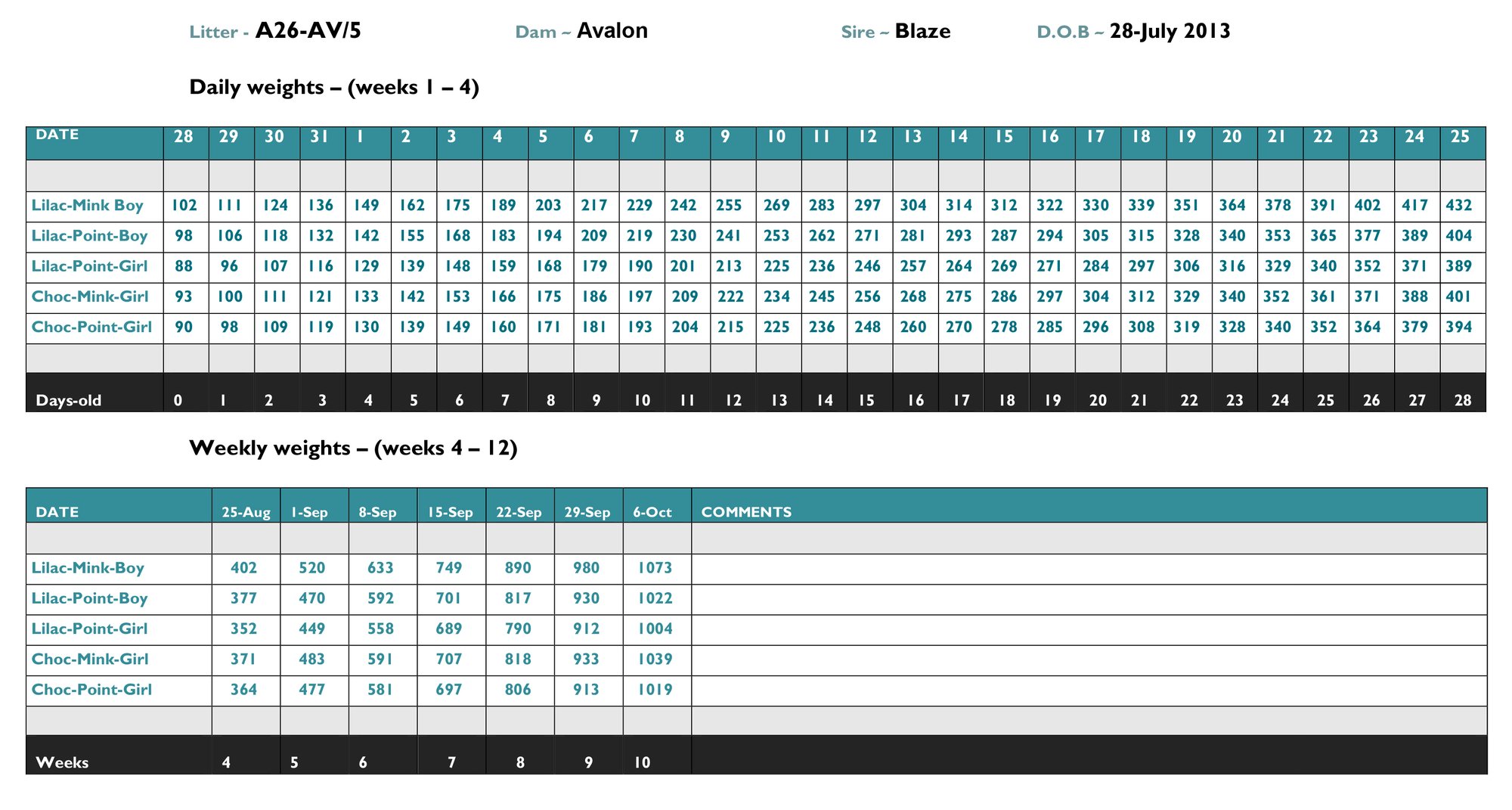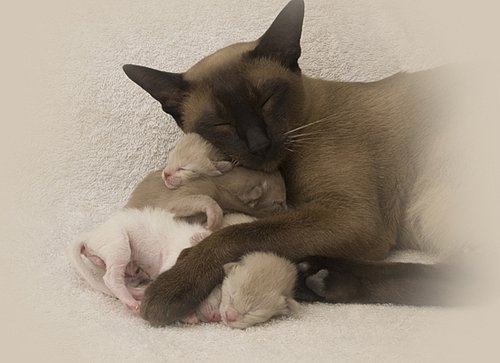The Birth of an Anniesong Kitten
At Anniesong all our kittens are precious - we have litters only twice or sometimes 3 times yearly so the arrival of a litter of kittens never loses it's 'shine'. And although it's always an exciting time at Anniesong when kittens are due, birthing can however be a nerve-wracking time as there is much that could go wrong and there is an anxious wait in the lead-up to the birth.
Our girls are only bred once yearly on average - leaving them much of the year to enjoy life as a pet and as a show-cat.
It all begins with a mating and our girls are matched to a particular stud for a variety of reasons. Sometimes the 'match' is to result in specific colour and pattern combinations, often it is to balance or match type of the prospective parents, and it is always with a view to breeding stunning temperaments in our kittens. As we currently have 5 resident and working studs this gives us lots of scope and having all our studs 'on-premises' means I'm also able to monitor the matings that occur..
Pregnancy or the gestation period for a Tonkinese lasts an average of 65 days, although our girls do tend to birth on day 64 in about 80% of cases. As the day of birth approaches - our Tonk-mums begin to be especially smoochy - and as their hormone levels rise, they instinctively seek out potential birthing spots, particularly a new mum that has yet to learn the routine. Cupboards and wardrobes are explored (and rearranged) in preparation for the impending birth.
When the day of birth arrives there is more pronounced change in the mum-to-be. Now her former 'neediness' is elevated to a whole new level as she becomes extremely clingy and demanding of company. Almost without exception our Tonk-mums insist on my presence for the birth of their babies and if i'm not home when they are due they will hold off labour until I return home. Often it has been the case that I'm met at the door by an anxious mum-to-be, who vocalising loudly will lead me directly to their birthing-room and her waters will then break within moments of sitting down with her. Ava is the only girl that has frequently surprised me with a litter, born during the night or when I'm at work or out.
We frequently breed two of our girls at the same time, and this gives an opportunity for them to share the experience of raising their babies and the mums seem to particularly enjoy the company.
This is especially valuable for our new mums, as the experienced mum then acts as a guide and mentor to the newbie. The current exception is miss Storm who despite being bred twice at the same time as another mum made it abundantly clear that she was not for sharing.
Co-parenting mums seem to be more relaxed - perhaps feeling more secure with a 'helper' - and I've noticed that co-parenting mums will frequently take turns to mind the bubs while the other goes visiting or just has a rest.
The time has arrived...... so labour has begun, and waters are broken - it can still be some time before kittens number one arrives. It always amazes me that a cat knows what to do instantly and instinctively how to act when the birthing process begins.
The Birthing process begins with the onset of uterine contractions. During this stage, the cervix starts to dilate and a clear, odourless discharge is usually seen. This discharge is known as the 'mucus plug' and its purpose during the pregnancy was to create a seal between the uterus and the vagina. As the birth of the first kitten becomes more imminent, the interval between the contractions decreases.
In the lead-up to birth the kitten moves down the birth canal. Pressure on the cervix stimulates the mother’s urge to push. She will often be straining visibly to push the kitten out. Each kitten comes in its own 'sack' or membrane and often a 'bubble' of liquid is seen protuding immediately prior to the birth. As the contractions increase in number and frequency the first kitten is born.
The mother will tear and lick the membrane from the face and body, to stimulate breathing in the kitten. A short time after the kitten’s birth, the placenta is delivered. And its usually only after the delivery of each placenta that the mother will normally sever the umbilical cord and eat the placenta.
If a kitten is in the breach position the birth of that kitten can be more difficult than one of 'normal presentation', and this can sometimes need veterinary intervention. From my records about 1 of 6 births occurs in the breach position, and this can be especially difficult for our young mums.
A breach birth often results in the kitten's head remaining inside after the body has emerged and is the most difficult aspect of the breach birth.
When Leia had her first litter and kitten number 1 was in the breach position and an extremely anxious hour was spent watching a tail emerge only to disappear back inside repeatedly.
Finally Leia was able to give birth naturally, just as I was preparing a carrier to take her to the emergency vet as this was taking place on a Saturday night.
While our Tonkinese mum waits for the birth of subsequent kittens, she is busy cleaning and drying her first kitten and depending on the interval between kittens will often feed the newborn kitten(s)
Normally a newborn kitten will instinctively seek out the mother's teats, and although blind and deaf at birth the newborn is driven by a powerful and well developed sense of smell. Indeed it is often the smell of the milk that stimulates the kitten to feed.
While I am present for nearly all births, I seldom intervene in the birthing process and only if I feel it is absolutely necessary. New mums in particular are frequently restless and highly mobile during the birthing process and could easily stand on or sit on a new born kitten while attending to another kitten, and so occassionally I will put the damp kittens inside my shirt to keep them warm and dry until mum is ready to settle.
Once all kittens have been born the mother will usually make this obvious by a change in her demeanour - her restlessness gives way to a more relaxed disposition, and once her kittens are all feeding she will often fall asleep as the birthing process has been an exhausting experience, particularly for our new mums.
The newborn kittens are also exhausted from the birthing process and tend to sleep between feeds for the first few hours.
For me too, there is a huge sense of relief and I can then finally relax once all babies are safely delivered and settling in to their first day outside of the womb and getting to know their mum.

 ATonkinese kitten at just a day old is settling into life outside the comfort of the womb. Their mother has become powerfully bonded with her babies through suckling them, and she is keep busy cleaning, feeding her brood.
ATonkinese kitten at just a day old is settling into life outside the comfort of the womb. Their mother has become powerfully bonded with her babies through suckling them, and she is keep busy cleaning, feeding her brood.
She is fiercely protective and if in any way feel that her kittens are threatened will react instinctively to defend her babies. and hell hath no fury like a mother cat in protective mode.
It is vitally important that all of the kittens feed from their mum regularly during the first 24-48 hours, to ensure they receive sufficient colostrum that is essential to building their immunity.
The mother protects her kittens and takes care of them with little need for intervention from humans.
 At Anniesong we also weigh all our kittens daily for the first 4 weeks - subsequent to that they are weighed once weekly to ensure that they are maintaining their growth rate and making adequate progress. The benefit of monitoring their daily weight gains are multifold;
At Anniesong we also weigh all our kittens daily for the first 4 weeks - subsequent to that they are weighed once weekly to ensure that they are maintaining their growth rate and making adequate progress. The benefit of monitoring their daily weight gains are multifold;
Additionally the weighing process enables critical monitoring of each indvidual kitten's growth rate to ensure they are receiving adequate nutrition and provides the opportunity for intervention should a kitten not be making sufficient weight gains.










